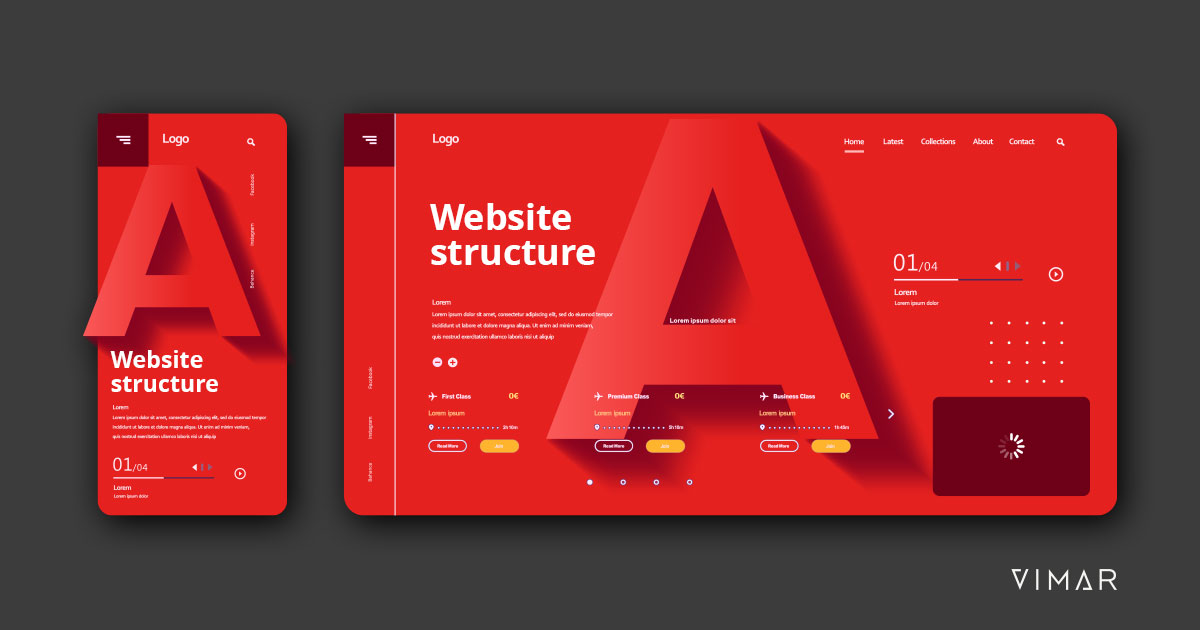In the online realm, a well-organised website structure stands as the backbone of your virtual space, ensuring that users can navigate seamlessly while enhancing its visibility on search engine results.
In this article, we will delve into the crucial role of website structure and how it can significantly impact your SEO efforts. By understanding the importance of a well-structured site, you can take proactive steps to construct a robust framework that drives organic traffic and boosts user experience.
So, grab your pen and paper because we are about to unravel the secrets of effective website structuring!
The SEO Benefits of a Well-Structured Website
You’ll experience significant SEO benefits when you have a well-structured website. One of the main advantages is that search engines can easily crawl and index your site, leading to better visibility in search results. When your website has a clear and logical structure, it becomes easier for search engine algorithms to understand the content and relevance of each page. This means that when someone searches for keywords related to your business, there’s a higher chance that your website will appear in the top results.
Another benefit of a well-structured website is improved user experience. When visitors come to your site, they want to find the information they’re looking for quickly and easily. A well-organized structure helps them navigate through your pages seamlessly, making their experience more enjoyable and increasing the likelihood of them staying on your site longer.
Additionally, a well-structured website makes it easier for you to optimize individual pages for specific keywords. By organizing your content into categories or sections, you can target different topics or themes on each page, enhancing the relevance and ranking potential for those keywords.
Steps to Construct a Robust Website Structure
To construct a robust website structure, start by outlining the key pages and sections that will make up your site. This will provide you with a clear roadmap for organizing your content and ensuring a seamless user experience. Here are three essential steps to follow:
- Identify your main navigation: Imagine your website as a house, with each page representing a different room. Your main navigation acts as the hallway that connects these rooms. Determine which pages are most important and should be easily accessible from every part of your site.
- Create sub-pages and categories: Think of sub-pages as individual rooms within each section of your website. These help organize your content into logical groupings, making it easier for visitors to navigate and find what they’re looking for.
- Establish internal linking: Just like hallways connecting different rooms, internal links connect various pages within your site. They guide users through related content and improve search engine visibility by allowing search engines to crawl and index all areas of your website effectively.
Harnessing the Power of Contextual Internal Linking
Harnessing the power of contextual internal linking can significantly improve user experience and increase search engine visibility. When you strategically place relevant links within your website content, you make it easier for users to navigate through your site and find the information they need. This not only enhances their overall experience but also keeps them engaged and encourages them to stay on your site longer.
By incorporating contextual internal links, you create a web of interconnected pages that guide users through different sections of your website. This helps in organizing your content and making it more accessible to both users and search engines. When search engines crawl your site, they follow these links to discover new pages and understand the relationship between them. As a result, your website becomes more visible in search engine results pages (SERPs), increasing the likelihood of attracting organic traffic.
Moreover, contextual internal linking allows you to establish a hierarchy within your website structure, with important pages receiving more link authority than others. By prioritizing certain pages with strategic links from other high-ranking pages, you can enhance their visibility in search results and drive targeted traffic towards them.
Creating Impactful Landing Pages
When creating impactful landing pages, it’s important to consider the needs and expectations of your target audience. You want to make sure that your landing page captures their attention and encourages them to take action.
Here are three key elements to keep in mind when designing your landing page:
- Compelling headline: Your headline should instantly grab the reader’s attention and convey the value they will receive by engaging with your offer. It should be clear, concise, and compelling.
- Engaging visuals: Visuals play a crucial role in capturing the audience’s interest. Use high-quality images or videos that are relevant to your offer and help convey its benefits.
- Clear call-to-action: Your call-to-action (CTA) is what prompts the visitor to take the desired action, whether it’s making a purchase, signing up for a newsletter, or downloading an ebook. Make sure your CTA stands out on the page and clearly communicates what you want them to do.
By incorporating these elements into your landing page design, you can create an impactful experience for your audience that not only meets their needs but also exceeds their expectations.
Strategies for Sustaining an Effective Site Structure
Maintaining an effective site structure is essential for keeping your website organized and user-friendly. By implementing strategies to sustain this structure, you can ensure that visitors can easily navigate through your site, find the information they need, and have a positive user experience.
One strategy is to categorize your content into logical sections or categories. This allows users to quickly identify what they are looking for and helps search engines understand the organization of your website. Additionally, it’s important to use descriptive and concise page titles and headings that accurately reflect the content on each page. This not only helps users understand the purpose of each page but also improves search engine optimization.
Another strategy is to create a clear hierarchy within your site structure. Use subfolders or subdirectories to organize related pages under broader categories. This makes it easier for both users and search engines to comprehend the relationship between different pages on your website.
Furthermore, regularly auditing and updating your site structure is crucial. As new content is added or old content becomes outdated, make sure to review and reorganize accordingly. Remove any broken links or duplicate pages that may negatively impact user experience.
Utilising Tools for Efficient Internal Linking
To efficiently utilize tools for internal linking, you should use plugins or software that automatically suggests relevant pages to link within your content. These tools can be a game-changer when it comes to optimizing your website’s structure and improving user experience. They take the guesswork out of finding suitable pages to link to and save you valuable time in the process.
When using these plugins or software, here are three ways they can enhance your internal linking strategy:
- Suggested Relevant Pages: Imagine having a tool that scans through your website and suggests relevant pages to link within your content. It analyzes keywords, topics, and even user behavior to provide you with a list of potential links. This feature ensures that every link you include is highly relevant and adds value to the reader.
- Automatic Anchor Text Generation: With these tools, you no longer need to spend time thinking about anchor text variations for each link. They can generate anchor text suggestions based on the content being linked from and linked to, ensuring consistency throughout your site.
- Broken Link Identification: Nothing frustrates users more than clicking on a broken link. These tools scan through your website regularly, identifying any broken links so you can fix them promptly. This not only improves user experience but also helps boost SEO by eliminating broken links that could harm your rankings.
Delving Deeper into the Importance of Website Structure
Now that you have learned how to utilize tools for efficient internal linking, let’s delve deeper into the importance of website structure. A well-structured website is crucial for providing a seamless user experience and optimizing your site for search engines.
Think of your website structure as the blueprint or foundation of your online presence. It determines how your content is organized and accessed by both users and search engine crawlers. A clear and logical structure makes it easier for visitors to navigate through your site, find relevant information, and take desired actions.
To help you understand the significance of website structure, here is a table highlighting its key benefits:
| BENEFITS OF WEBSITE STRUCTURE | |
|---|---|
| Improved User Experience | A well-structured site enhances usability, reduces bounce rates, and increases user engagement. |
| Enhanced SEO Performance | Properly organizing your content enables search engines to crawl and index your pages more efficiently. This can improve your rankings in search results. |
| Better Conversion Rates | An intuitive navigation system guides users towards conversion points, such as making a purchase or filling out a form. |
In conclusion, the significance of website structure cannot be overstated when it comes to optimizing your online presence. As we’ve explored in this article, a well-structured website offers a multitude of advantages, including improved user experience, enhanced SEO performance, and higher conversion rates. When your website’s framework is organized and intuitive, it not only facilitates smoother navigation for visitors but also ensures that search engines can effectively crawl and index your content, ultimately boosting your visibility in search results. By following the steps outlined for constructing a robust website structure, harnessing the power of contextual internal linking, creating impactful landing pages, and implementing strategies for maintaining an effective site structure, you can pave the way for online success. So, as you embark on your journey to optimize your website for better search engine rankings, remember that the key to success lies in the careful planning and maintenance of your website’s structure.

We are a creative digital marketing agency with true passion and experience. Our goal is to help you grow your business and brand through the power of digital marketing. All our efforts are focused on increasing our customers’ sales and promoting their brand. We do this by improving website design and search engine visibility, generating interest on social media, and implementing cutting-edge marketing strategies.
If you would like to learn more about digital marketing and how it could help transform your business, you can book a free consultation call with our team today.





Keep In Touch